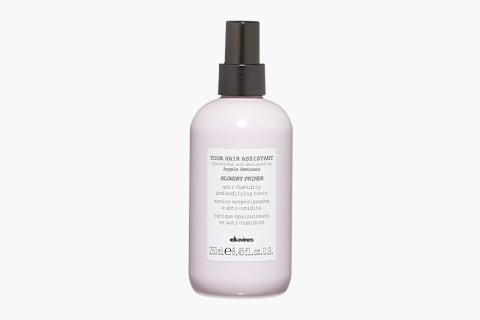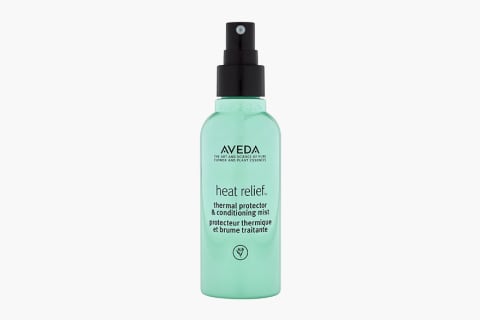Advertisement
Use Natural Hair Care Products? Make Sure You're Not Doing This


A few years ago, I became obsessed with hair oils, of all kinds. Wake up? Slick back fly-aways with coconut oil. At work on my lunch break? Whip out my travel bottle of argan oil to hydrate my ends. Before bed? Apply castor oil. On the weekend? DIY olive oil mask. I wanted to tend to my dry, dehydrated hair, and vats of oils were my solution.
Here's the problem: During that time in my ever-evolving hair journey, I was also doing plenty of heat styling with blowtorch-like dryers and searing flatirons.
"Basically almost anything you put on your hair can act as a heat protectant—except for oils," says hairstylist Clay Nielson. "If you put oils in your hair then go to use a super-hot flatiron, bam, all of a sudden you're making breakfast. You're literally cooking your hair."
What is heat damage—and what does it look like?
"It's when the strand has been compromised by using a very intense heat source," says hairstylist Sal Misseri. "This could be both after a single use of extreme heat or repetitive use."
The easiest way to locate heat damage is to look at your ends: It'll appear dry, lifeless, frayed, and frizzy. If you have color-treated hair, the hue will run flat, dull, and often brassy. If you have naturally textured hair, you might notice stretched-out or uneven curl patterns throughout your head.
How can I protect my hair while sticking to natural products?
"Heat protectants are simply products designed to withstand high temperatures by creating a barrier around the hair shaft and protecting the hair's cuticle," says Misseri. Ideally, too, your heat protectant will also have hair healing actives as well. "There are many different ingredients used, but you should look for options formulated with antioxidants as well as proteins to help strengthen the hair."
Because these products need to coat the hair without weighing it down and withstand intense heat, effective, 100-percent natural protectants are hard to formulate. But there are a few close-to-all-natural options we love: Davines Your Hair Assistant Blowdry Primer also cuts down drying time and Aveda Heat Relief Thermal Protector & Conditioning Mist is perfect for restyling on already dry hair.
Shop These Products:
And with heat styling, your technique matters just as much as your products: As you are applying, make sure your hair is fully saturated with the product. "Every strand that isn't coated with the product isn't getting protected," says Misseri. Most people simply coat the top, front layer, and forget about the rest of the head. Instead, divide your hair into small individual sections to apply thoroughly.
While you are actually styling, don't overheat your tools. ("It depends on the texture and density of the hair, as well as if it's chemically treated, but I strongly urge to never go above 400°F," says Misseri.) Also always be mindful of how long you are using heat in a specific area, as well as how often. It's why you'll see more damage by the hairline since most people tend to style more there than other areas.
Are there any oils that are OK to use before heat?
Here's where things get interesting! If you are a dedicated oil user, not all options are off limits: You just need to use appropriately. For any foodie out there, you probably know that different oils have different burning points. It's why if you cook with olive oil, your kitchen will smoke up faster than if you did, say, sunflower seed oil: Olive oil can start burning at temperatures as low as 320°F while sunflower seed oil burns at around 440°F.
And there are a few popular oils that have high smoke points that are also great for hair: We recommend sunflower seed, grapeseed, argan, and avocado oils.
So, yes, technically if you are using an oil that has a high burn temperature, and making sure your hot tool is set to below that, you can probably get away with using it beforehand. But your safest bet for a heat protectant is to stick to a product formulated for it.
Watch Next
Enjoy some of our favorite clips from classes
Enjoy some of our favorite clips from classes
What Is Meditation?
Mindfulness/Spirituality | Light Watkins
Box Breathing
Mindfulness/Spirituality | Gwen Dittmar
What Breathwork Can Address
Mindfulness/Spirituality | Gwen Dittmar
The 8 Limbs of Yoga - What is Asana?
Yoga | Caley Alyssa
Two Standing Postures to Open Up Tight Hips
Yoga | Caley Alyssa
How Plants Can Optimize Athletic Performance
Nutrition | Rich Roll
What to Eat Before a Workout
Nutrition | Rich Roll
How Ayurveda Helps Us Navigate Modern Life
Nutrition | Sahara Rose
Messages About Love & Relationships
Love & Relationships | Esther Perel
Love Languages
Love & Relationships | Esther Perel



















